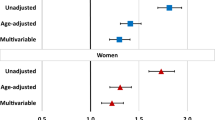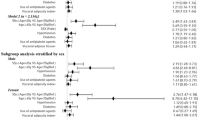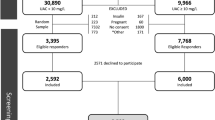Abstract
Background:
Previous studies have indicated that fat distribution is important in the development of cardiovascular disease (CVD). We investigated the association between fat distribution, as measured by dual energy X-ray absorptiometry (DXA), and the incidence of stroke.
Methods:
A cohort of 2751 men and women aged ⩾40 years was recruited. Baseline levels of abdominal, gynoid and total body fat were measured by DXA. Body mass index (BMI, kg m−2) was calculated. Stroke incidence was recorded using the regional stroke registry until subjects reached 75 years of age.
Results:
During a mean follow-up time of 8 years and 9 months, 91 strokes occurred. Of the adiposity indices accessed abdominal fat mass was the best predictor of stroke in women (hazard ratio (HR)=1.66, 95% confidence interval (CI)=1.23–2.24 per standard deviation increase), whereas the ratio of gynoid fat to total fat mass was associated with a decreased risk of stroke (HR=0.72, 95% CI=0.54–0.96). Abdominal fat mass was the only of the adiposity indices assessed that was found to be a significant predictor of stroke in men (HR=1.49, 95% CI=1.06–2.09). The associations between abdominal fat mass and stroke remained significant in both women and men after adjustment for BMI (HR=1.80, 95% CI=1.06–3.07; HR=1.71, 95% CI=1.13–2.59, respectively). However, in a subgroup analyses abdominal fat was not a significant predictor after further adjustment for diabetes, smoking and hypertension.
Conclusion:
Abdominal fat mass is a risk factor for stroke independent of BMI, but not independent of diabetes, smoking and hypertension. This indicates that the excess in stroke risk associated with abdominal fat mass is at least partially mediated through traditional stroke risk factors.
This is a preview of subscription content, access via your institution
Access options
Subscribe to this journal
Receive 12 print issues and online access
$259.00 per year
only $21.58 per issue
Buy this article
- Purchase on Springer Link
- Instant access to full article PDF
Prices may be subject to local taxes which are calculated during checkout
Similar content being viewed by others
References
WHO. Obesity: preventing and managing the global epidemic. Report of WHO Consultation on Obesity, 3–5 June 1997. WHO: Geneva, 1998. (Edited by WHO: Geneva, 2006).
Burton BT, Foster WR, Hirsch J, Van Itallie TB . Health implications of obesity: an NIH Consensus Development Conference. Int J Obes 1985; 9: 155–170.
Must A, Spadano J, Coakley EH, Field AE, Colditz G, Dietz WH . The disease burden associated with overweight and obesity. JAMA 1999; 282: 1523–1529.
Donnan GA, Fisher M, Macleod M, Davis SM . Stroke. Lancet 2008; 371: 1612–1623.
Dobkin BH . Clinical practice. Rehabilitation after stroke. N Engl J Med 2005; 352: 1677–1684.
Hu G, Tuomilehto J, Silventoinen K, Sarti C, Mannisto S, Jousilahti P . Body mass index, waist circumference, and waist-hip ratio on the risk of total and type-specific stroke. Arch Intern Med 2007; 167: 1420–1427.
Abbott RD, Behrens GR, Sharp DS, Rodriguez BL, Burchfiel CM, Ross GW et al. Body mass index and thromboembolic stroke in nonsmoking men in older middle age. The Honolulu Heart Program. Stroke 1994; 25: 2370–2376.
Rexrode KM, Hennekens CH, Willett WC, Colditz GA, Stampfer MJ, Rich-Edwards JW et al. A prospective study of body mass index, weight change, and risk of stroke in women. JAMA 1997; 277: 1539–1545.
Yusuf S, Hawken S, Ounpuu S, Bautista L, Franzosi MG, Commerford P et al. Obesity and the risk of myocardial infarction in 27,000 participants from 52 countries: a case-control study. Lancet 2005; 366: 1640–1649.
Winter Y, Rohrmann S, Linseisen J, Lanczik O, Ringleb PA, Hebebrand J et al. Contribution of obesity and abdominal fat mass to risk of stroke and transient ischemic attacks. Stroke 2008; 39: 3145–3151.
Walker SP, Rimm EB, Ascherio A, Kawachi I, Stampfer MJ, Willett WC . Body size and fat distribution as predictors of stroke among US men. Am J Epidemiol 1996; 144: 1143–1150.
Folsom AR, Rasmussen ML, Chambless LE, Howard G, Cooper LS, Schmidt MI et al. Prospective associations of fasting insulin, body fat distribution, and diabetes with risk of ischemic stroke. The Atherosclerosis Risk in Communities (ARIC) Study Investigators. Diabetes Care 1999; 22: 1077–1083.
Tanne D, Medalie JH, Goldbourt U . Body fat distribution and long-term risk of stroke mortality. Stroke 2005; 36: 1021–1025.
Snijder MB, Dekker JM, Visser M, Bouter LM, Stehouwer CD, Kostense PJ et al. Associations of hip and thigh circumferences independent of waist circumference with the incidence of type 2 diabetes: the Hoorn Study. Am J Clin Nutr 2003; 77: 1192–1197.
Wiklund P, Toss F, Weinehall L, Hallmans G, Franks PW, Nordstrom A et al. Abdominal and gynoid fat mass are associated with cardiovascular risk factors in men and women. J Clin Endocrinol Metab 2008; 93: 4360–4366.
Park YW, Heymsfield SB, Gallagher D . Are dual-energy X-ray absorptiometry regional estimates associated with visceral adipose tissue mass? Int J Obes Relat Metab Disord 2002; 26: 978–983.
Nielsen S, Guo Z, Johnson CM, Hensrud DD, Jensen MD . Splanchnic lipolysis in human obesity. J Clin Invest 2004; 113: 1582–1588.
Hill AM, LaForgia J, Coates AM, Buckley JD, Howe PR . Estimating abdominal adipose tissue with DXA and anthropometry. Obesity (Silver Spring) 2007; 15: 504–510.
Snijder MB, Visser M, Dekker JM, Seidell JC, Fuerst T, Tylavsky F et al. The prediction of visceral fat by dual-energy X-ray absorptiometry in the elderly: a comparison with computed tomography and anthropometry. Int J Obes Relat Metab Disord 2002; 26: 984–993.
Stegmayr B, Lundberg V, Asplund K . The events registration and survey procedures in the Northern Sweden MONICA Project. Scand J Public Health Suppl 2003; 61: 9–17.
Hunt KJ, Lukanova A, Rinaldi S, Lundin E, Norat T, Palmqvist R et al. A potential inverse association between insulin-like growth factor I and hypertension in a cross-sectional study. Ann Epidemiol 2006; 16: 563–571.
Weinehall L, Hallgren CG, Westman G, Janlert U, Wall S . Reduction of selection bias in primary prevention of cardiovascular disease through involvement of primary health care. Scand J Prim Health Care 1998; 16: 171–176.
Rexrode KM, Carey VJ, Hennekens CH, Walters EE, Colditz GA, Stampfer MJ et al. Abdominal adiposity and coronary heart disease in women. JAMA 1998; 280: 1843–1848.
Nicklas BJ, Penninx BW, Cesari M, Kritchevsky SB, Newman AB, Kanaya AM et al. Association of visceral adipose tissue with incident myocardial infarction in older men and women: the Health, Aging and Body Composition Study. Am J Epidemiol 2004; 160: 741–749.
Tanko LB, Bagger YZ, Alexandersen P, Larsen PJ, Christiansen C . Central and peripheral fat mass have contrasting effect on the progression of aortic calcification in postmenopausal women. Eur Heart J 2003; 24: 1531–1537.
Bergman BC, Cornier MA, Horton TJ, Bessesen DH . Effects of fasting on insulin action and glucose kinetics in lean and obese men and women. Am J Physiol Endocrinol Metab 2007; 293: E1103–E1111.
Despres JP, Lemieux I . Abdominal obesity and metabolic syndrome. Nature 2006; 444: 881–887.
Fain JN, Madan AK, Hiler ML, Cheema P, Bahouth SW . Comparison of the release of adipokines by adipose tissue, adipose tissue matrix, and adipocytes from visceral and subcutaneous abdominal adipose tissues of obese humans. Endocrinology 2004; 145: 2273–2282.
Fried SK, Bunkin DA, Greenberg AS . Omental and subcutaneous adipose tissues of obese subjects release interleukin-6: depot difference and regulation by glucocorticoid. J Clin Endocrinol Metab 1998; 83: 847–850.
Van Pelt RE, Evans EM, Schechtman KB, Ehsani AA, Kohrt WM . Contributions of total and regional fat mass to risk for cardiovascular disease in older women. Am J Physiol Endocrinol Metab 2002; 282: E1023–E1028.
Boyko EJ, Fujimoto WY, Leonetti DL, Newell-Morris L . Visceral adiposity and risk of type 2 diabetes: a prospective study among Japanese Americans. Diabetes Care 2000; 23: 465–471.
Hansson GK, Libby P . The immune response in atherosclerosis: a double-edged sword. Nat Rev Immunol 2006; 6: 508–519.
Fontana L, Eagon JC, Trujillo ME, Scherer PE, Klein S . Visceral fat adipokine secretion is associated with systemic inflammation in obese humans. Diabetes 2007; 56: 1010–1013.
Heitmann BL, Frederiksen P, Lissner L . Hip circumference and cardiovascular morbidity and mortality in men and women. Obes Res 2004; 12: 482–487.
Vague J . The degree of masculine differentiation of obesities: a factor determining predisposition to diabetes, atherosclerosis, gout, and uric calculous disease. Am J Clin Nutr 1956; 4: 20–34.
Tanko LB, Bagger YZ, Alexandersen P, Larsen PJ, Christiansen C . Peripheral adiposity exhibits an independent dominant antiatherogenic effect in elderly women. Circulation 2003; 107: 1626–1631.
Pouliot MC, Despres JP, Moorjani S, Lupien PJ, Tremblay A, Nadeau A et al. Regional variation in adipose tissue lipoprotein lipase activity: association with plasma high density lipoprotein levels. Eur J Clin Invest 1991; 21: 398–405.
Renstrom F, Payne F, Nordstrom A, Brito EC, Rolandsson O, Hallmans G et al. Replication and extension of genome-wide association study results for obesity in 4923 adults from Northern Sweden. Hum Mol Genet 2009; 18: 1489–1496.
Acknowledgements
This research was funded by Visare Norr and The Swedish Society of Medicine.
Author information
Authors and Affiliations
Corresponding author
Ethics declarations
Competing interests
The authors declare no conflict of interest.
Rights and permissions
About this article
Cite this article
Toss, F., Wiklund, P., Franks, P. et al. Abdominal and gynoid adiposity and the risk of stroke. Int J Obes 35, 1427–1432 (2011). https://doi.org/10.1038/ijo.2011.9
Received:
Revised:
Accepted:
Published:
Issue Date:
DOI: https://doi.org/10.1038/ijo.2011.9
Keywords
This article is cited by
-
Combined consideration of body mass index and waist circumference identifies obesity patterns associated with risk of stroke in a Chinese prospective cohort study
BMC Public Health (2022)
-
A Single Nucleotide Polymorphism in the FADS1 Gene is Associated with Plasma Fatty Acid and Lipid Profiles and Might Explain Gender Difference in Body Fat Distribution
Lipids in Health and Disease (2017)
-
Schlaganfall – Lifestyle und Umwelt
Der Nervenarzt (2015)
-
Effect of combined training versus aerobic training alone on glucose control and risk factors for complications in type 2 diabetic patients: a meta-analysis
International Journal of Diabetes in Developing Countries (2015)
-
Association between different obesity measures and the risk of stroke in the EPIC Spanish cohort
European Journal of Nutrition (2015)



